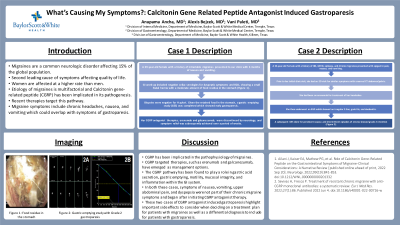Sunday Poster Session
Category: Stomach
P1363 - What’s Causing My Symptoms? Calcitonin Gene Related Peptide Antagonist Induced Gastroparesis
Sunday, October 22, 2023
3:30 PM - 7:00 PM PT
Location: Exhibit Hall

Has Audio

Anupama Ancha, MD
Baylor Scott & White Medical Center
Temple, TX
Presenting Author(s)
Anupama Ancha, MD1, Alexis Bejcek, MD1, Vani Paleti, MD2
1Baylor Scott & White Medical Center, Temple, TX; 2BSWH, Killeen, TX
Introduction: Migraines are a common neurologic disorder affecting 15% of the global population. They are the second leading cause of symptoms affecting the quality of life of patients, and women are affected at a higher rate than men. The etiology of migraines is multifactorial, and the Calcitonin gene-related peptide (CGRP) has been implicated in its pathogenesis, with recent therapies targeting this pathway. Migraine symptoms include chronic headaches, nausea, and vomiting which could overlap with symptoms of gastroparesis. We present two cases of CGRP antagonist induced gastroparesis.
Case Description/Methods: Case 1: A 39-year-old female with a history of intractable migraines presented to our clinic with 6 months of nausea and vomiting. GI work-up included negative celiac serologies for dyspeptic symptoms and EGD, which showed a small hiatal hernia and a moderate amount of food residue in the stomach (Figure 1). Biopsies were negative for H pylori. Given the retained food in the stomach, a gastric emptying study (GES) was completed which showed early gastroparesis. Her CGRP antagonist therapies, erenumab and galcanezumab, were discontinued by neurology, and symptom relief was subsequently achieved over a period of weeks.
Case 2: A 33-year-old female with a history of IBS, GERD, epilepsy, and chronic migraines presented with epigastric pain, nausea, and vomiting. Before her initial clinic visit, she had an ED visit for similar symptoms with a normal CT abdomen/pelvis. She had been on erenumab for treatment of her headaches. She then underwent an EGD which showed an irregular Z-line, gastritis, and duodenitis. A subsequent GES done for persistent nausea and intermittent episodes of emesis showed grade 2 retention (Figure 2).
Discussion: CGRP has been implicated in the pathophysiology of migraines. Therefore, CGRP targeted therapies, such as erenumab and galcanezumab, have emerged as management options. Interestingly, the CGRP pathway has been found to play a role in gastric acid secretion, gastric emptying, motility, mucosal integrity, and inflammation within the GI system.
In both these cases, symptoms of nausea, vomiting, upper abdominal pain, and dyspepsia were not part of their chronic migraine symptoms and began after initiating CGRP antagonist therapy.
These two cases of CGRP antagonist induced gastroparesis highlight important side effects to consider when deciding on a treatment plan for patients with migraines as well as a differential diagnosis to include for patients with gastroparesis.

Disclosures:
Anupama Ancha, MD1, Alexis Bejcek, MD1, Vani Paleti, MD2. P1363 - What’s Causing My Symptoms? Calcitonin Gene Related Peptide Antagonist Induced Gastroparesis, ACG 2023 Annual Scientific Meeting Abstracts. Vancouver, BC, Canada: American College of Gastroenterology.
1Baylor Scott & White Medical Center, Temple, TX; 2BSWH, Killeen, TX
Introduction: Migraines are a common neurologic disorder affecting 15% of the global population. They are the second leading cause of symptoms affecting the quality of life of patients, and women are affected at a higher rate than men. The etiology of migraines is multifactorial, and the Calcitonin gene-related peptide (CGRP) has been implicated in its pathogenesis, with recent therapies targeting this pathway. Migraine symptoms include chronic headaches, nausea, and vomiting which could overlap with symptoms of gastroparesis. We present two cases of CGRP antagonist induced gastroparesis.
Case Description/Methods: Case 1: A 39-year-old female with a history of intractable migraines presented to our clinic with 6 months of nausea and vomiting. GI work-up included negative celiac serologies for dyspeptic symptoms and EGD, which showed a small hiatal hernia and a moderate amount of food residue in the stomach (Figure 1). Biopsies were negative for H pylori. Given the retained food in the stomach, a gastric emptying study (GES) was completed which showed early gastroparesis. Her CGRP antagonist therapies, erenumab and galcanezumab, were discontinued by neurology, and symptom relief was subsequently achieved over a period of weeks.
Case 2: A 33-year-old female with a history of IBS, GERD, epilepsy, and chronic migraines presented with epigastric pain, nausea, and vomiting. Before her initial clinic visit, she had an ED visit for similar symptoms with a normal CT abdomen/pelvis. She had been on erenumab for treatment of her headaches. She then underwent an EGD which showed an irregular Z-line, gastritis, and duodenitis. A subsequent GES done for persistent nausea and intermittent episodes of emesis showed grade 2 retention (Figure 2).
Discussion: CGRP has been implicated in the pathophysiology of migraines. Therefore, CGRP targeted therapies, such as erenumab and galcanezumab, have emerged as management options. Interestingly, the CGRP pathway has been found to play a role in gastric acid secretion, gastric emptying, motility, mucosal integrity, and inflammation within the GI system.
In both these cases, symptoms of nausea, vomiting, upper abdominal pain, and dyspepsia were not part of their chronic migraine symptoms and began after initiating CGRP antagonist therapy.
These two cases of CGRP antagonist induced gastroparesis highlight important side effects to consider when deciding on a treatment plan for patients with migraines as well as a differential diagnosis to include for patients with gastroparesis.

Figure: Figure 1 - Food residue noted on EGD
Figure 2A - Nuclear medicine GES results with anterior and posterior views showing moderate retention of food in the stomach after 4 hours indicative of grade 2 gastroparesis
Figure 2B - Graphic representation of GES results showing 50% gastric emptying time of 148 minutes and 21% retention at 4 hours
Figure 2A - Nuclear medicine GES results with anterior and posterior views showing moderate retention of food in the stomach after 4 hours indicative of grade 2 gastroparesis
Figure 2B - Graphic representation of GES results showing 50% gastric emptying time of 148 minutes and 21% retention at 4 hours
Disclosures:
Anupama Ancha indicated no relevant financial relationships.
Alexis Bejcek indicated no relevant financial relationships.
Vani Paleti indicated no relevant financial relationships.
Anupama Ancha, MD1, Alexis Bejcek, MD1, Vani Paleti, MD2. P1363 - What’s Causing My Symptoms? Calcitonin Gene Related Peptide Antagonist Induced Gastroparesis, ACG 2023 Annual Scientific Meeting Abstracts. Vancouver, BC, Canada: American College of Gastroenterology.
